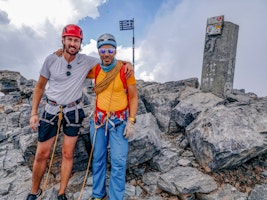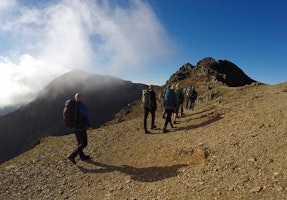Nestled in the heart of Iran, you’ll find Mount Damavand, waiting for you. It really is a magical peak and has special significance for Iranian people both from a mythical and a geographical sense.
At 5610 meters, it is Iran’s highest mountain and for this reason, it’s often known as the “Roof of Iran”. It’s also the highest natural point in the Middle East and the highest volcano in Asia. This fact gains the peak entry to the Volcanic Seven Summits club, a group of the highest volcanoes in each continent. It’s so iconic in Iran that you can even find an image of it on the back of the Iranian 10,000 rials banknote.
In Iranian mythology, there is a legend that says a three-headed dragon called Aži Dahāka resides on the mountain and is destined to remain there until the end of time.
How and when you attempt the climb will impact your experience so it’s important to do your research before you set out. Read on for essential information for trekking the peak.
3 Reasons to trek Mt Damavand
Scenery
It really is one of the most beautiful volcanoes in the world. Just to look at from a distance is impressive but to actually trek it is a whole other experience entirely. You’ll trek over the clouds, watch sunsets and really feel like you’re are on the top of the world, or at least on top of Iran. Mount Damavand is situated in the Lar National Park and there you’ll find exceptional native flora and fauna. Then, from the summit, you’ll be treated to an amazing view of the Lar Valley.
Cultural importance
Visible from Tehran, Mt Damavand is an important symbol for the Iranian people. It features heavily in Persian poetry and literature. The long Persian poem the Shahnameh states the mountain has magical powers. It also appears in the Iranian legend of Arash where a magical arrow is shot from the mountain to mark Iran’s border.
Physical challenge
We’re talking about the highest volcano in all of Asia here. Trekking Damavand is no easy feat. It’s comparable to climbing Mount Kilimanjaro. So, getting to the top is an achievement of your physical and mental strength.
 Trekking Mount Damavand
Trekking Mount Damavand
Visit local villages and mountain communities during your trek. Photo courtesy of Iran Plateau.
Where is Mount Damavand? How to get there?
This peak is situated in the Lar National Park in the Mazandaran province of Iran. It’s roughly 80 km northeast of Tehran in the Alborz Mountains and 70 km south of the Caspian Sea.
Getting there from the Imam Khomeini International Airport in Tehran will take a little over two hours via Route 7 and Route 77. There are shuttles that go between the two locations and your guide will normally assist you with this. You can also get a taxi.
How long does it take to climb Mount Damavand?
Ideally, you should take 3-5 days to reach the summit. It can be done in as little as two days. However, that is not advisable if you haven’t climbed it before.
While the trek is not technically that difficult, the altitude gain should not be underestimated. The air gets pretty thin up there. You’ll thank yourself later for taking the time to properly acclimatize, either with acclimatization hikes or by staying in a mountain hut for an extra night.
There is a lot of beautiful nature to be seen here, so if you wish you can add more days to your trek. One great option is to visit the Abe Garm Larijan hot springs in a nearby Lar Valley village. There you can rest your tired legs and experience the local culture.
 Trekking Mount Damavand
Trekking Mount Damavand
Camp overnight, high in the mountains on your way to the summit. Photo courtesy of EST Adventure.
What are the main climbing routes for Mount Damavand?
There are actually 16 routes to the top in total, however, there are four in particular that we would recommend for your climb. These four routes are the North, Northeast, South and West. Each of the routes has a different starting point on the mountain and they all require a transfer to the starting point.
The South Route
This is the most straightforward and requires basic trekking skills. The descent is especially easy and often experienced mountaineers who have taken more difficult routes up, choose this route for the descent.
There are mountain huts along the way, like Polour Hut. You can also get porter and mule support on this route, something that cannot be guaranteed on other routes. Rescue teams can also reach the south route faster if there were to be any emergencies.
As this is the most popular route it can also get pretty busy which puts the facilities under pressure. This can mean less space, particularly on the weekends. There is almost always room for tents, however.
The West Route
This route is again quite straightforward on the way up however the last 200 meters of the ascent is very steep. Like the south route, the first basecamp you reach is Polour Hut.
If you do take this route, it’s important to take enough water as there are not many opportunities to refill along the way. This path gives you awesome sunset views and some people choose it for that alone.
 Trekking Mount Damavand
Trekking Mount Damavand
You’ll have a crew of porters and mules to help you with your belongings as you climb. Photo courtesy of EST Adventure.
The North East Route
The North East route is the longest route. It’s also one that requires mountaineering experience. It can get extremely cold on the way up, there are also strong winds to contend with. You’ll find one shelter at 4,500 meters called Takht e Fereydoun. The views from the Northeast route are the most beautiful of all the routes.
The North Face Route
This is the most challenging route and requires some experience. It’s quite steep in parts and involves scrambling. The wind is often strong on this route. It is also much colder than the south route, there is often snow and ice in May and June. There are two shelters along this route at 4,000 meters and then at 4,800 meters.
 Trekking Mount Damavand
Trekking Mount Damavand
Experience traditional huts as you trek through the mountains. Photo courtesy of EST Adventure.
How hard is it to hike up Mount Damavand?
This depends in part when you decide to climb and which route you decide to follow. It is not a technical climb however no trail to the top is easy. The south route is the best for trekkers with less experience and a good level of fitness. If you’re looking for a challenge and have trekking experience, the Northeast or North route might be better.
One factor to bear in mind is that close to the top there are pretty strong smelling sulfur vapors. Add that to already thin air and you have some tricky conditions. For this reason, the final push to the summit is normally started around 4 am to avoid the winds the pick up in the day and make it difficult to breathe.
The altitude gain is high too and this is not something to be underestimated. Your guide will help you ascend Damavand sensibly to account for acclimatization, but experience trekking at altitudes of 4000 meters and up will be advantageous.
 Trekking Mount Damavand
Trekking Mount Damavand
Enjoy epic views as you get higher and higher. Photo courtesy of EST Adventure.
What’s the best time for the Mt Damavand trek?
Summer and the beginning of Autumn are the best times for a relatively straight forward hike to the summit. In the winter there is heavy snow cover and the journey to the summit turns into a ski-mountaineering experience rather than a trek.
What equipment do I need to hike Mount Damavand?
You won’t need much technical equipment for your Mount Damavand trek. However, the weather conditions can be difficult and changeable, with sudden winds and cold temperatures. For this reason, it’s important to have technical clothing. Here’s a list of the equipment you’ll need, some of which your guide may provide:
Gaiters
Trekking shoes and socks
Trekking pants
Gore-tex jacket and pants
Cotton t-shirts
Polar jacket
Gore-Tex jacket
Gloves and woolen hat
Sunglasses
Sunscreen SPF 50 and lip balm
Headlamp
Sleeping bag (suitable for up to -10), mattress, tent
Main backpack plus a small attacking backpack
Trekking poles
Cooking gear
Small personal first-aid kit
Water Bottles (and purification tablets)
Toiletries
Headlamp
Swiss Army knife
 Trekking Mount Damavand
Trekking Mount Damavand
Take on the challenge of trekking Mount Damavand as part of a group. Photo courtesy of EST Adventure.
So, now you know what it takes to trek to the Mount Damavand Summit. To get the most out of your experience it’s important that you embark on this adventure with a certified guide. Explore the various guided trip options on offer and book your perfect Damavand experience today.







